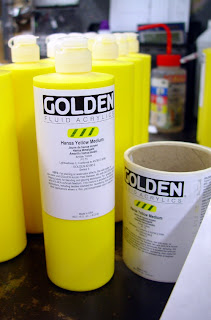This is some tips that you learn along the way by experience in exploring colour and the results of colours mixing.. The sky is the limit and with so many possibilities and results, having some tips can help you embrace the process and find ways to use some colours you didn't like in the first place.
When I was learning at ISCD, we had to paint numerous paint chimp to experience and embrace the colour..
Add Dark to Light
It takes only a little of a dark color to change a light color, but it
takes considerably more of a light color to change a dark one.
So, for
example, always add black to yellow to darken it, rather than trying to tint black with yellow - you might have to use the all tube of yellow and might not be very cost effective. (I have seen this and it is very frustrating when it happens)
See the example above.
Same thing add yellow into the white to create a tinted yellow.
Don't be scared and embrace the challenge and get
mixing. At worst you’ll produce mud colors (I call them also the colour you dislike - often it happens when you are becoming upset about the mixing) ; if you don’t want to waste
the paint by throwing it away, use it with some white to do a tonal
exercise, or underpainting.
Add Opaque to Transparent
Same thing when mixing an opaque colour and a transparent one.
Add a
little of the opaque to the transparent one, rather than the
other way round. The opaque colour has a far greater strength or
influence than a transparent colour.
I use Matisse and Golden Paint and they have an example of the paint opacity or transparency on the tube.. always a good tip to remember..
Don’t Overmix
When you mix two colours together on a palette, you don’t mix and mix
until they’re totally combined...
Using two blues and mixing them as above can create some amazing and interesting result when you put the
mixed colour down on canvas.
The result is a colour that’s
intriguing, varies slightly across the area you’ve applied it, it will have more depth to it.
Happy painting!!


